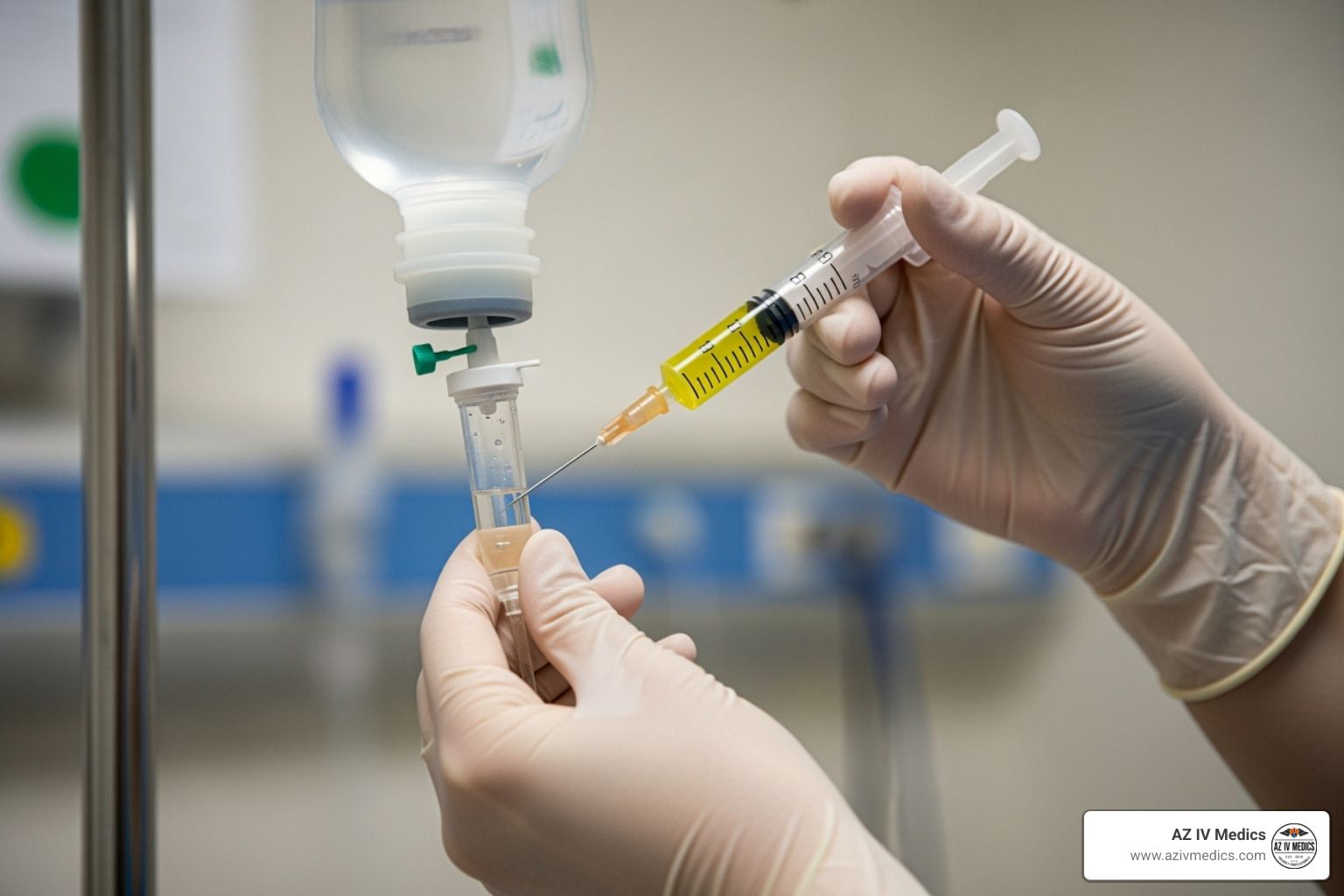IV antibiotics side effects can range from mild discomfort to serious allergic reactions that require immediate medical attention. When you receive intravenous antibiotics through an IV line, the medication enters your bloodstream directly, making it a powerful treatment option for bacterial infections. Understanding potential side effects helps patients recognize warning signs early and communicate effectively with their healthcare team about any concerns during treatment.
What Are IV Antibiotics?
Intravenous antibiotics are medications delivered directly into the bloodstream through a needle or catheter to treat serious bacterial infections. This method allows the antibiotic to reach high concentrations quickly throughout the body, making it ideal for severe infections that don't respond well to oral medications. Healthcare providers typically administer IV antibiotics in hospitals, outpatient clinics, or through home health nurse services using specialized equipment like PICC lines or IV catheters. While
mobile IV therapy services primarily focus on wellness and hydration, understanding IV delivery methods helps patients appreciate how medications enter the bloodstream.
Common Side Effects of IV Antibiotics
Most patients receiving IV antibiotic therapy experience mild side effects that resolve without intervention. The injection site may become red, swollen, or tender where the nurse inserts the catheter. Diarrhea occurs frequently because antibiotics disrupt the natural balance of bacteria in your digestive system, affecting your microbiome and sometimes causing dysbiosis.
Nausea and vomiting are common complaints, particularly with broad-spectrum antibiotics that target multiple types of bacteria. Some patients develop a skin rash that appears as small red bumps or patches across the body. Headaches and dizziness can occur as your body adjusts to the medication entering your bloodstream directly through the IV line.
What Are Serious Allergic Reactions to IV Antibiotics?
Allergic reactions represent the most concerning side effects of IV antibiotics and require immediate medical attention. Penicillin and cephalosporins are the most common culprits for allergic reactions, though any antibiotic class can trigger a response. Symptoms may include difficulty breathing, chest tightness, swelling of the face or throat, and severe skin rash that spreads rapidly.
Anaphylaxis is a life-threatening allergic reaction that can develop within minutes of receiving the first dose. Your doctor will ask about any history of penicillin allergy or reactions to cephalosporin antibiotics before prescribing treatment. Medical staff closely monitor patients during the first administration of any new antibiotic. The nurse typically stays nearby for at least 15-30 minutes after starting the infusion to watch for signs of allergic reactions.
How Do Different Antibiotic Types Cause Side Effects?
Each class of antibiotics works differently to fight bacterial infections, which explains why side effects vary by medication type. Ceftriaxone and Cefazolin are cephalosporin antibiotics that interfere with bacterial cell walls, causing them to break down and die. These medications can cause diarrhoea and may increase the risk of secondary infections like Clostridioides difficile.
Fluoroquinolones represent another category of broad-spectrum antibiotics with unique side effects. This class can cause tendon problems, nerve damage, and photosensitivity that makes your skin more sensitive to sunlight. The Centers for Disease Control and Prevention notes that fluoroquinolones should be reserved for serious infections when other options aren't suitable.
What Are the Risks of IV Line Complications?
The IV catheter itself can cause problems separate from the antibiotic medication. Phlebitis occurs when the vein becomes inflamed around the injection site, causing pain, redness, and warmth. Healthcare providers flush the line with saline or heparin to keep it clear and reduce the risk of complications. Similar to how
IV therapy for hydration uses proper catheter care, antibiotic administration requires strict protocols.
Infection at the catheter insertion site poses a significant risk, especially with long-term IV access through PICC lines. The nurse cleans the area thoroughly before inserting the needle and changes dressings regularly following strict protocols. Signs of infection include increasing pain, discharge, red streaks extending from the site, or fever.
How Does Antibiotic Resistance Relate to Side Effects?
Antibiotic resistance develops when bacteria evolve to survive exposure to antibiotics that previously killed them. Using antibiotics unnecessarily or not completing prescribed courses contributes to this growing problem. While resistance itself isn't a side effect for the patient, it means future infections may be harder to treat.
The patient may experience prolonged illness or require stronger medications with more severe side effects when facing antimicrobial-resistant infections. Doctors now prescribe antibiotics more cautiously, ensuring they're treating true bacterial infections rather than viral illnesses. Blood samples and stool culture tests help identify the specific bacteria causing infection so providers can choose targeted antibiotics.
When Should You Contact Your Doctor About Side Effects?
Most mild side effects don't require immediate intervention, but certain symptoms demand urgent medical attention. Contact your doctor immediately if you develop difficulty breathing, severe skin rash spreading across your body, chest pain, or signs of anaphylaxis. Severe or bloody diarrhea, especially with fever and abdominal cramping, could indicate Clostridioides difficile infection.
Changes in urination patterns, confusion, or yellowing of the skin may signal kidney disease or liver disease complications from the medication. Don't stop taking your antibiotics without consulting your doctor, even if you're experiencing uncomfortable side effects. Incomplete treatment can lead to antibiotic resistance and allow the bacterial infection to return stronger.
What Can You Do to Minimize Side Effects?
Several strategies help reduce the risk and severity of IV antibiotic side effects. Stay well-hydrated by drinking plenty of water, which helps flush the medication through your system and reduces kidney strain. Understanding
proper hydration becomes especially important during antibiotic treatment. Probiotics may help maintain gut bacteria balance, though you should consult your doctor before adding supplements during treatment.
Report any drug interactions by providing a complete list of all medications, supplements, and herbal products you're taking. Your nurse monitors the IV site regularly, but you should also watch for signs of problems between scheduled checks. Maintain good nutrition during treatment to support your immune system and recovery.
Are There Special Considerations for Certain Patients?
Some patients face higher risks of side effects from IV antibiotics. Those with existing kidney disease or liver disease require careful dose adjustments and close monitoring through blood tests. The medication dosage must be modified to prevent toxic buildup in the bloodstream when these organs aren't functioning optimally.
Pregnant and breastfeeding women need antibiotics selected specifically for safety during these periods. Certain antibiotics can harm developing babies or pass into breast milk in concerning amounts. Elderly patients and those with blood disorders may experience more pronounced side effects or complications. Healthcare providers adjust treatment plans based on individual patient factors and medical history.
Understanding the Benefits Versus Risks
IV antibiotics remain essential tools for treating serious bacterial infections that could otherwise become life-threatening. Conditions like strep throat progressed to invasive infection, endocarditis, and Gonorrhea complications often require intravenous treatment. The benefits of curing these infections typically outweigh the risks of side effects when proper precautions are followed.
Your healthcare team carefully selects antibiotics based on the specific bacteria causing your infection, your medical history, and potential side effect profiles. They consider factors like penicillin allergy, previous reactions to cephalosporins, and existing health conditions when making treatment decisions. This personalized approach minimizes risks while maximizing treatment effectiveness.
Understanding IV antibiotics side effects empowers you to participate actively in your healthcare. By recognizing normal versus concerning reactions, following proper IV catheter care procedures, and maintaining open dialogue with your medical team, you can navigate antibiotic treatment safely and effectively while minimizing complications. If you're interested in learning more about
IV therapy options for wellness and recovery, exploring professional mobile services can provide additional support for your health journey.







